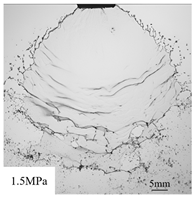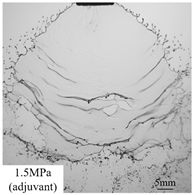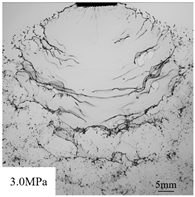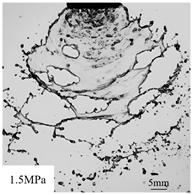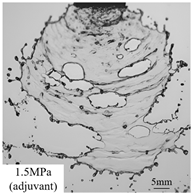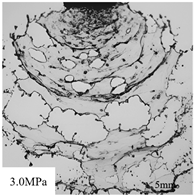Abstract
The structural parameters of the liquid sheet represent a significant factor influencing the atomization performance, and its measurement is an important part of the agrochemical atomization study. Currently, the measurement predominantly relies on commercial software with manual operation, which is labor intensive and inefficient. In this study, deep learning methods with high-speed photographing were employed to measure the structural parameters of the liquid sheet of hydraulic nozzles with different atomization modes. The LM-YOLO liquid sheet structure recognition model was constructed to recognize the liquid sheet and perforations. Based on the recognition results, a method is designed to calculate several key parameters, including the breakup length, the liquid sheet area, the spray angle, the average number of perforations, and the average perforation area. A comparative scrutiny of the assorted liquid sheet structural parameters under different experimental conditions was also implemented. Based on the constructed model, a recognition accuracy of 81.0% for the liquid sheet structure of the LU nozzle (a classical hydraulic nozzle with high liquid sheet integrity) and 71.3% for the IDK nozzle (an air-induced hydraulic nozzle with a certain amount of bubbles in the liquid sheet) was achieved. The liquid sheet structure was measured based on the recognition results. It was found that the pressure has a significant impact on the structural parameters of the liquid film. For the LU120-03 nozzle, the breakup length of the liquid film decreases from 48.96 mm to 39.05 mm as the pressure increases. In contrast, for the IDK120-03 nozzle, the breakup length exhibits fluctuating changes, with a peak value of 29.65 mm occurring at 250 kPa. After adding silicone adjuvant, the breakup length and area of the liquid film generally decrease. The variation trends of the measured structural parameters under different experimental conditions are consistent with the trends of the data in previous relevant research by other scholars. This study provides a new method for measuring out the structural parameters of the liquid sheet, and it has potential application in related fields.
1. Introduction
Spraying, as a fundamental and indispensable operation in agricultural management, plays a crucial role in crop production. In the applications of agrochemicals, the delivery of a liquid to a target location is typically performed by spraying through a nozzle [,,,]. The liquid exits the nozzle in the form of a sheet, which breaks up due to the interaction with the surrounding air and surface tension forces []. The manner in which the sheet breaks up and the atomization parameters of the spray that are eventually formed (e.g., volume median diameter (VMD), uniformity coefficient, deposition, etc.) are key factors in assessing spray efficiency []. The spray characteristic parameters, including spray velocity, entrained air characteristics, spray angle, and spray structure, are pivotal in determining the atomization parameters [,,]. Accurate acquisition of these parameters is crucial for elucidating the mechanism of influence on atomization parameters, thereby optimizing the spraying effect and enhancing pesticide utilization.
A number of techniques have been developed with the aim of precisely measuring the liquid sheet structure. Instrumentation can be utilized to measure breakup length. Using electrical connectivity, an invasive probe analyzes electrical potentials, enabling the identification of the breaking point. In contrast, optical connectivity employs laser excitation of liquids with added fluorescent dye to aid in determining the breaking point. Charalampous et al. investigated the measurement of breakup length, comparing optical connectivity, electrical connectivity, and shadowgraphic imaging techniques. Their findings revealed that at low momentum ratios, high-speed and low-speed shadowgraphic imaging exhibited greater concordance with electrical connectivity measurements, while optical connectivity measurements were comparatively shorter. Conversely, at high momentum ratios, optical connectivity demonstrated alignment with high-speed shadow imaging outcomes, whereas low-speed shadowgraphic imaging outcomes were observed to be relatively longer, and electrical connectivity results were found to be shorter []. The electrical connectivity method has several limitations: it is physically invasive, can only measure a single parameter, and requires complicated result interpretation. On the other hand, the optical connectivity method faces challenges, including the need to modify the nebulizer, limited measurement length, and high equipment requirements.
With the development of the high-speed camera, it has become an effective approach to further understand the breakup characteristics and physical mechanisms of atomization through images []. The liquid sheet morphology varied significantly under different conditions. Based on the qualitative analysis of high-speed photographic images and the measurement of structural parameters (spray angle, breakup length, liquid sheet area, etc.), the differences and changes in breakup mechanisms under different conditions were discussed, and the effects of physicochemical condition changes on spray structure, particle size distribution, and the influence of spray structure on particle size distribution were explored [,,,,,,]. It should be noted that the liquid sheet structure parameters in these studies were manually measured using traditional image processing methods and commercial software. The atomization process is characterized by significant uncertainty, with liquid sheet edges and perforations exhibiting continuous and irregular changes, which collectively impede the automated measurement of liquid sheet structure and render them labor intensive and inefficient.
Benefiting from the development of artificial intelligence, image recognition technology can build a recognition system with higher precision and broader applicability by virtue of the powerful computing power of artificial intelligence, despite the obscurity of its underlying mechanisms. This technology has been demonstrated to enhance the quality, yield, and sustainability of agricultural production []. Precisely evaluating atomization spray performance is an indispensable approach to improving agricultural quality. When integrated with image recognition technology, this approach assumes a particularly pivotal role. Specifically, based on high-speed photographic images of liquid sheets, Chen et al. utilized Deep Convolutional Networks (Deep CNNs) for the training of segmentation network models, which were subsequently employed for the evaluation of spray distributions [], whereas Li et al. used machine learning and deep learning methods, respectively, to categorize the high-speed photographic video clips of liquid sheets and combine droplet size parameters (Dv10, Dv50, Dv90, which represent the droplet size particle size corresponding to 10%, 50%, and 90% of the accumulated volume, respectively) to regress the droplet size parameters with the images for prediction [,]. In studies targeting high-speed photographic images of liquid membranes, no researchers have attempted to recognize the specific liquid sheet structure. It is anticipated that the potential for the application of image recognition techniques can be further explored in the field of atomization.
A novel approach to measuring spray structures is proposed in this study. Different from traditional image processing methods, an attempt is made to employ deep learning algorithms to train neural network models to recognize liquid sheets and perforations in high-speed photographic images. Based on the recognition results, several structures of the liquid sheet were measured with the assistance of the code. Subsequently, a comparative analysis and discussion of the structural parameters under diverse experimental conditions are conducted in light of the measurement results.
2. Materials and Methods
2.1. Experimental Materials
Four commonly used flat fan nozzles, LU120-03, LU120-015, IDK120-03, and IDK120-015 (Lechler Inc., Metzingen, Germany), were selected in this study. The LU nozzle is a common flat fan nozzle, which produces a flat liquid sheet, thereby ensuring uniform coverage and overlapping spray patterns []. IDK nozzles are air-induction nozzles, which are conventional flat fan nozzles to which a mixing chamber is added with a small perforation in the side; the fluid flow decreases the pressure inside this chamber, causing air to be sucked in and mixed with the fluid. As a result, the liquid sheet contains “holes” []. Table 1 lists the specific orifice sizes. The commercial adjuvant used in the experiments is extremely moist silicone adjuvant (Dowsilicon materials technology (Shanghai) Co., Ltd., Shanghai, China).

Table 1.
Detailed parameters of nozzle orifice.
2.2. Experimental Platform
An experimental platform was established for capturing high-speed photographic images of the liquid sheet. As shown in Figure 1, the schematic diagram of the platform, it is composed of the following components: a water tank, an inverter pump (PRODN INTELLIGENT PUMP (ANHUI) Co., Ltd., Wuhu, Anhui, China) that adjusts pressure via a digital control panel and offers a more stable pressure compared to the DC diaphragm pump, a pressure stabilizer tank (Xiamen Doofar Outdoor Co., Ltd., Xiamen, China) that stabilizes the pressure in a constant-pressure water supply system, prevents pressure fluctuations during spraying, reduces the frequent startup of the pump, and makes the water flow smoother, and a pressure gauge for monitoring the pressure inside the pipe during the experiment. Both can operate normally within the pressure range set in the experiment. The flat fan nozzle used is in accordance with that described in Section 2.1. The distance between the chamber and the spray nozzle is 1.64 m.
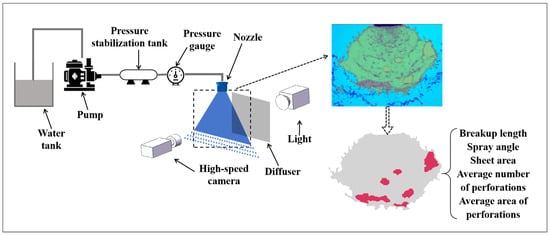
Figure 1.
The experimental platform comprises a series of interconnected components, including water tanks, pumps, pressure regulator tanks, pressure gauges, flat fan nozzles, high-speed camera, LED sun lamps, and diffuser.
The high-speed camera used to capture the liquid sheet images is consistent with the instrument used by Zhang et al. The initial atomization area was captured using a 12-bit line-by-line scanning camera (Imager Pro HS 4 M CMOS camera, LaVision, Göttingen, Germany). The resolution of the camera CCD was 2016 × 2016 pixels, with a pixel size of 11 × 11 μm. A professional photographic LED sunlamp (EF-200, Jinbei, Shanghai, China) served as the light source. To ensure even light distribution, a high transmittance frosted acrylic sheet is installed between the light source and the atomizing liquid sheet for diffusion of light [].
2.3. Liquid Sheet Image Capture Experiment
The experiment was conducted at the atomization laboratory of the Beijing Academy of Agriculture and Forestry Sciences (39°94′9230″ N, 116°29′2370″ E), Beijing, China, in July 2024. A series of high-speed photographic images of the liquid sheet were collected based on the constructed experimental platform. The mean temperature during the experiment was 25 °C, with a relative humidity of 27%. The temperature of the water and solution is 21.7 °C []. The spraying pressures for the experiment were set at 150 kPa, 200 kPa, 250 kPa, 300 kPa, 350 kPa, and 400 kPa. These six pressure levels are sufficient to meet the requirements of routine plant protection operations []. The spraying solutions selected for the experiment were tap water and a solution with a concentration of 0.01‰ of the extremely moist silicon adjuvant. To circumvent the issue of dynamic blurring and obtain comprehensive data regarding the morphological evolution of the liquid sheet while also preventing damage to the photographic apparatus caused by LED illumination, the shutter speed was set to 5000. Four distinct nozzles were utilized to spray varying solutions under the specified pressures for imaging. Each instance, the high-speed camera was operated to capture and save 1000 liquid sheet images.
3. Liquid Sheet Structure Recognition Modeling and Parameters Measurement
3.1. Recognition Model
In this study, YOLOv8s is selected as the basis for the model architecture, with consideration given to the parameter scale and model performance. In the context of the variable target morphology and uneven distribution inherent to the liquid sheet dataset, the original YOLOv8s architecture is prone to leakage detection issues and exhibits reduced accuracy. Aiming at the characteristics of the liquid sheet dataset, this study proposes LM-YOLO (structure shown in Figure 2). In the backbone network, the core structure of LSKNet is used to replace the bottleneck structure in C2f, and the C2f_Lsk module is established to augment the feature extraction capacity of the network backbone. Incorporating Multi-branch-Assisted FPN (MAFPN) into the neck structure enhances the network’s capacity to retain shallow feature information, thereby improving its ability to utilize feature layer information interactively. The transition from CIoU to EIoU loss function accelerates convergence and enhances regression accuracy.
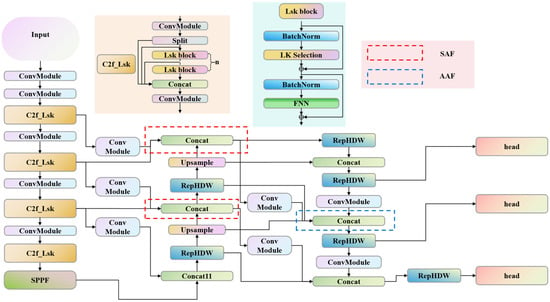
Figure 2.
Structure of LM-YOLO.
3.1.1. C2f_LSK Module: Dynamically Capturing Liquid Sheet Image Features via Selective Kernels
The traditional convolutional operations are constrained in their ability to process morphologically variable targets and complex background images due to the fixed sense field and weight distribution. In this study, the core structure of LSKNet (Large Selective Kernel Network) [] is employed to supplant the bottleneck structure of C2f (shown in Figure 3), which can dynamically adjust the large spatial receptive field, and flexibly adjust the range of spatial information required for processing according to the different object sizes and context ranges in the image.
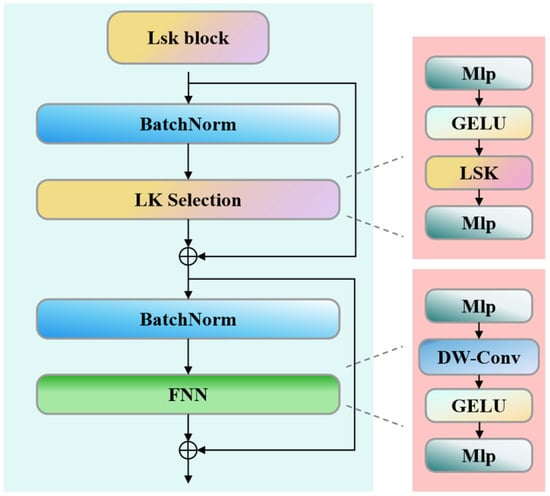
Figure 3.
LSK block core structure.
The core structure encompasses two sub-blocks. The LK Selection sub-block employs two large-scale convolutional kernels of distinct sizes to process the original input in a parallel manner. Subsequently, after splicing the convolutional outputs, further feature fusion operations are executed to obtain the output feature maps. This enables the network to synchronously acquire multi-scale feature information of the liquid sheet image and flexibly adjust the processing capacity in accordance with the size and complexity of the objects within the image. Consequently, the ability to capture minute alterations in liquid sheet morphology and edge details within complex backgrounds is enhanced, thereby improving the recognition efficacy. The feed-forward network (FFN) sub-block is utilized for channel mixing and feature refinement. The first fully connected layer accomplishes feature transformation, endowing the network with enhanced learning capabilities. Deep convolution independently applies spatial filtering between channels, which reduces the parameter count while preserving the effect. Moreover, the GELU activation function introduces nonlinearities to augment the model’s expressiveness. This sub-block is directly followed by the LK Selection sub-block, to maintain the spatial information of the liquid sheet features while augmenting the network’s representational power on the feature channels.
3.1.2. MAF Module: Multi-Scale Feature Integration of Liquid Sheet Image
The fundamental neck structure PAFPN of YOLOv8 is insufficient in the effective integration and fusion of multi-scale information originating from different resolution layers. To improve the network’s ability to represent minute features (such as the edges of the liquid sheet and surface ripples) in the liquid sheet image, a novel neck structure named the multi-branch-assisted FPN (MAFPN) [] is introduced, and the schematic diagram of the core structure is illustrated in Figure 4.
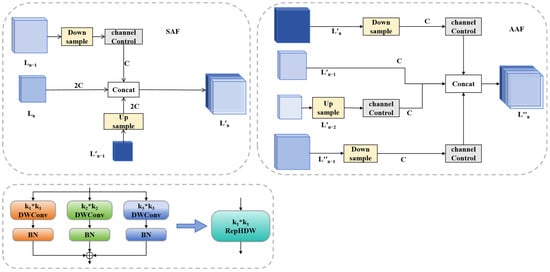
Figure 4.
MAFPN core sub-block structure.
In the MAFPN, Superficial Assisted Fusion (SAF) preserves the information of the shallow backbone through bidirectional connections and integrates the deep information with the features from the same hierarchical level and the high-resolution shallow layer within the backbone network, thus retaining more detailed information for the network. To further enhance the interactive utilization of the feature layer information, Advanced Assisted Fusion (AAF) enriches the gradient information of the output layer through multi-directional connections. As illustrated in the figure, the AAF structure involves the information aggregation across the shallow high-resolution layer L′n−2, the shallow low-resolution layer L′n, the sibling shallow layer L′n−1, and the previous layer L′′n−1, with the output layer integrating information from four different layers. Based on the concept of Re-parameterization, the RepHDW sub-block is constructed. As shown in the figure, this sub-block contains depthwise convolutions (DWConvs) with different kernel sizes (k1 > k2 > k3). Through a procedure akin to padding, the small DWConvs are assimilated into the large DWConv. By merging convolution kernels of different sizes, the ability to represent across multiple scales is demonstrated while maintaining relatively low losses.
3.1.3. Optimize Loss Function: Boosting Regression Precision
CIoU is used in the base model of YOLOv8 to calculate the detection frame loss, and the formula for CIoU is shown in Equation (1):
where and , respectively, represent the center coordinates of the predicted box and true box, denotes the Euclidean distance between the two points, is used to measure the aspect ratio, and serves as a balancing parameter. CIoU reflects the difference in aspect ratios through in its formula, rather than the true differences in width and height from their respective confidence levels. EIoU disassembles the aspect ratio on the basis of CIoU, and its penalty term calculates the length and width of the target box and the anchor box, respectively. This loss function consists of three parts: overlap loss, center distance loss, and width–height loss. The first two parts follow the methods in CIoU, but the width–height loss directly minimizes the differences between the width and height of the target box and the anchor box. The formula for EIoU is shown in Equation (2):
where and indicate the width and height of the smallest enclosing area for both the predicted and true boxes. EIoU disassembles the loss term associated with the aspect ratio into the disparities between the predicted width and height and the width and height of the minimum outer enclosing frame, respectively. This approach enhances the regression accuracy. Consequently, the EIoU loss function is adopted in this study to acquire a model possessing greater accuracy and robustness.
3.2. Measurement of Structural Parameters
Write Python code to reconstruct the liquid sheet mask image using the coordinate information of the neural network recognition results. Measure a total of five parameters, including the liquid sheet structural parameters (liquid sheet spray angle, liquid sheet breakup length, liquid sheet area) and the perforation structural parameters (average number of perforations, average area of perforations). Due to the dynamic nature of the liquid sheet morphology during the spraying process, parameter measurement under each experimental condition is performed on 150 consecutive liquid sheet images (a total of 30 ms).
The typical liquid sheet breakup length is defined as the distance from the liquid sheet below the nozzle to the fragmented droplets on the liquid sheet centerline [], as indicated by the blue dashed line in Figure 5. Define the edge of the liquid sheet below the nozzle as the virtual origin, and the left and right virtual origins X1 and X2 are determined for each group of images, respectively. The midpoint of the two is used to determine the centerline of the liquid sheet. The breakup length is calculated as in Equation (3).
where the breakup length is the distance between the gray pixels at the ends of the centerline, is the vertical coordinate of the lowest edge pixel of the liquid sheet on the centerline, and is the vertical coordinate of the highest edge pixel of the liquid sheet on the centerline.
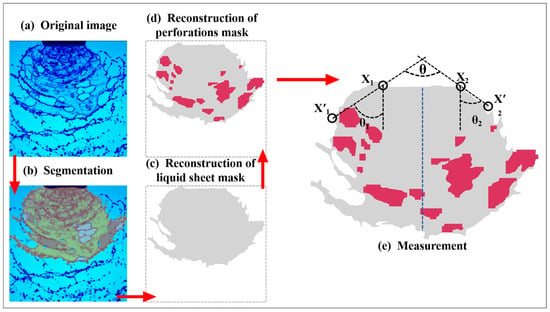
Figure 5.
Liquid sheet image recognition and structural parameters measurement methods. (a) Original image. (b) Segmentation. (c) Reconstruction of liquid sheet mask. (d) Reconstruction of perforations mask. (e) Measurement.
The angle encompassed by the two black dashed lines in Figure 5 represents the spray angle . The spray angle is defined as the angle formed by the liquid surface boundary in the vicinity of the nozzle being parallel to the flat fan surface. The location where the edge of the liquid sheet fractures and gives rise to a discontinuous liquid sheet is termed as the liquid sheet edge breaking point. During the measurement process, two edge breaking points, X′1 and X′2, are determined for each image. The calculation of the spray angle is presented in Equations (4)–(6).
Utilizing the coordinates (x, y) of the virtual origins (X1 and X2) and the edge breaking points (X′1 and X′2), calculate the angles and between the lines fitted by the two sets of points along the edge of the spray liquid surface, respectively. The sum of these two angles yields the liquid sheet spray angle .
The continuous liquid sheet that has not undergone breakup constitutes the measurement area for the liquid sheet area. Within this region, the perforations on the liquid sheet are counted, and their areas are measured. The calculations of the above-mentioned parameters are carried out using the pixel information of the gray mask and the red mask in the figure, respectively. The core code is shown in Table 2. Except for the spray angle and the number of perforations, the results measured by the code are in pixel data. The ratio of the width of the lower edge of the nozzle measured by a vernier caliper to the pixel length of the nozzle in the image is used as the scale factor for conversion in the code to obtain the actual structural parameters data.

Table 2.
Core codes for liquid sheet and area of perforations calculation.
4. Results and Discussion
4.1. Experimental Environment and Dataset
The experimental environment configuration is shown in Table 3.

Table 3.
Configuration of the experimental environment.
The training parameters are set as follows: the training period is 300 epochs, and it is automatically stopped after 50 training cycles without enhancement, the batch is set to 8, Mosaic data enhancement is used by default to turn off in the penultimate 10th round, and the image size is set to 640 × 640, with an initial learning rate set at 0.01.
The dataset is based on the images of flat fan liquid sheets captured under different experimental conditions using the established experimental platform. For each of the two types of nozzles, 720 images are selected to establish two individual datasets. The continuous liquid sheet regions and perforations are annotated using the annotation tool Labelme. Data augmentation methods such as flipping, rotating, and changing the brightness of the images are employed to expand the datasets. Subsequently, the datasets are divided into training sets, validation sets, and test sets in the ratio of 8:1:1.
4.2. Ablation Experiments
To validate the effectiveness of the module improvements in LM-YOLO and enhance the model robustness, an ablation experiment was designed. With YOLOv8s as the baseline model, the improved modules were successively superimposed step by step. The improved models were then trained and tested, and the results of the ablation experiment are shown in Table 4.

Table 4.
Results of the ablation experiment.
As can be discerned from Table 4, in the case where the models enhanced with C2f_LSK and MAF are employed independently, the mask accuracy is augmented by 1.9 and 1.2 percentage points correspondingly for the IDK dataset, and by 2.0 and 2.2 percentage points for the LU dataset. The combined application further boosts the model recognition performance, with enhancements of 2.3 and 2.9 percentage points, respectively, on the IDK and LU datasets. The combination of the newly integrated structures is capable of further strengthening feature extraction and expediting the interaction and fusion of shallow and deep feature information. Upon adding the EIoU loss function, the model performance attains the current optimal state, increasing to 81.0% and 71.3%, respectively, on the two datasets. Although the model size is slightly augmented, the number of parameters is reduced compared to YOLOv8s.
4.3. Comparative Experiment of Different Models
To further validate the superiority of the improved model in this study for the recognition of liquid sheet structure, a comparative experiment is conducted between the model in this study and traditional instance segmentation models, including Mask-RCNN [], YOLOv5s, YOLACT [], and DeepLabv3+ []. The experimental results are presented in Table 5. Although the model size and the number of parameters of the LM-YOLO model are at an intermediate level, the mask accuracy reaches 81% and 71.3% on the different datasets, respectively, which is superior to the five control model. It can be seen that our model has good recognition performance.

Table 5.
Comparative experimental results of different models.
4.4. Comparison and Analysis of Measurement Results of Structural Parameters
Train a liquid sheet recognition model based on LM–YOLO. Utilize the written code to recognize and measure liquid sheet images under different conditions. Summarize the measurement results of liquid sheet breakup length, spray angle, liquid sheet area, average number of perforations, and average area of perforations, and conduct a comparison and analysis. All measurements can be found in Table S1.
4.4.1. Analysis of Liquid Sheet Structural Parameters
Based on previous research, liquid sheet breakup modes have been categorized into three modes called rim, wave, and perforated-sheet disintegration [,]. The liquid sheet breakup mode of the LU nozzles is predominantly governed by wave disintegration, whereas that of the IDK nozzles is dominated by perforated-sheet disintegration. Under varying spraying pressures, differences exist in the liquid sheet structural parameters. Owing to the distinct liquid sheet breakup modes, the liquid sheet breakup length and the area of the liquid sheet from different nozzles show different trends in their variations.
In Figure 6, with the augmentation of pressure, the breakup length of the LU120-03 nozzle demonstrates a monotonically decreasing trend, descending from 48.96 mm to 39.05 mm, which implies a pronounced impact of pressure on the breakup length. In contrast, the breakup length of the IDK120-03 nozzle exhibits a fluctuating alteration. As the pressure rises, the breakup length first ascends and then descends, reaching a maximum value of 29.65 mm at a pressure of 250 kPa. The relative change rates of the breakup length before and after 250 kPa are 10.8% and −6.5%, respectively. The variation tendencies during the increasing and decreasing phases differ, with the decreasing phase relatively more gradual. It is observed that the breakup length at 400 kPa remains larger than that at 150 kPa. Yang et al. conducted a study on the variation in the breakup length by using the ST110-01 nozzle to spray water and a solution with an emulsion concentration of 0.1% []. The spraying pressure ranged from 100 kPa to 500 kPa. Through manual measurement using the image processing software Image-Pro Plus (IPP), it was found that for the liquid sheet dominated by wave disintegration, its breakup length continuously decreased with the increase in pressure, which was consistent with the measurement results in this study. However, for the liquid sheet dominated by perforated-sheet disintegration, due to the perforation caused by the emulsion, the breakup length increased with the increase in pressure. Different from this study, no inflection point where the variation trend changed significantly was observed. When the pressure was greater than 400 kPa, it was observed that the breakup length decreased slightly, which was in line with the variation trend observed in this study after the pressure was greater than 250 kPa.
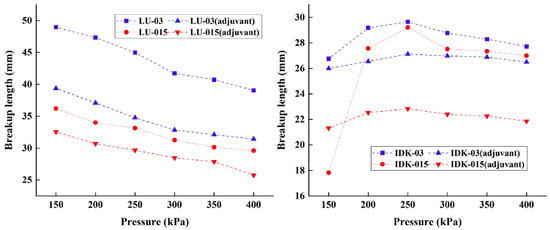
Figure 6.
Comparison of liquid sheet breakup length under different experimental conditions. The breakup length of LU nozzle showed a single decreasing trend with increasing pressure, IDK nozzle showed fluctuating change of increasing and then decreasing, and the overall level of the breakup length of the two decreased after the addition of adjuvant.
After adding adjuvant, the breakup length of the LU120-03 nozzle decreased from 39.37 mm to 31.42 mm with the increase in pressure, which was lower than that of the case without adjuvant. The breakup length of the IDK120-03 nozzle exhibited a similar trend, with a peak value of only 27.12 mm. It was found that the relative change in the breakup length was 4.3% and −2.3%, respectively, before and after the peak value, which was relatively smooth compared with that without adjuvant. The breakup of the liquid sheet is affected by the Rayleigh–Taylor instability []. After adding adjuvant, the surface tension of the solution decreased, and the liquid sheet is more likely to break under the same pressure. The addition of adjuvant not only affected the breakup length of the nozzle but also reduced the overall level of the breakup length under different pressure conditions.
The variation trends of the liquid sheet area of different series of nozzles with respect to pressure do not show fluctuations but exhibit opposite characteristics. As shown in Figure 7, when the pressure increases, the liquid sheet area of the LU120-03 nozzle continuously decreases, dropping from 1821.25 mm2 to 1246.84 mm2, with a relative change rate of −31.5%. In contrast, the liquid sheet area of the IDK120-03 nozzle showed an increasing trend from 486.78 mm2 to 605.44 mm2 with a relative change rate of 24.4%. Gong [] measured the liquid sheet area of the ST110-01 nozzle at 100 kPa, 300 kPa, and 500 kPa by means of traditional image processing methods and IPP. The emulsion concentration of the sprayed solution was 0.1%. The liquid sheet areas corresponding to the increasing pressures were 58.4 mm2, 72.51 mm2, and 77.63 mm2, respectively. For the liquid sheet breakup mode dominated by perforated-sheet disintegration, it was consistent with the variation trend of the measurement results in this study; that is, the liquid sheet area increased with the increase in pressure.

Figure 7.
Comparison of liquid sheet area under different experimental conditions. The liquid sheet area of different series of nozzles changes with pressure in opposite trend: the area of LU nozzles decreases, the area of IDK nozzles increases. After adding adjuvant, the values are lower than those without adjuvant.
Similar to the variation pattern of the breakup length, upon the addition of adjuvant into the solution and the consequent reduction in surface tension, the values of the liquid sheet area are generally lower than those of the measurement results obtained without adjuvant. The relative change rates of the liquid sheet area for the LU120-03 nozzle and the IDK120-03 nozzle become −28.3% and 9.5%, respectively, and the alteration in the liquid sheet area is more subdued. The decrease in surface tension renders the liquid sheet more susceptible to breakage, thereby indirectly “attenuating” the influence of pressure variation on the structural parameters.
Under different experimental conditions, the variation trends of the spray angle of each nozzle are consistent. As shown in Table 6, the spray angle of the LU120-03 nozzle increases from 81.6° to 133.5°, and the spray angle of the IDK120-03 nozzle increases from 90.9° to 112.8°. It is hypothesized that a positive correlation exists between pressure and spray angle, implying that a higher pressure leads to a larger spray angle. Yang [] measured the spray angle of the ST110-01 nozzle spraying water and a solution with an emulsion concentration of 0.02% under different pressures using the IPP in the experiment. Stallbaumer-Cyr [] utilized ImageJ to measure the spray angle of several fan nozzles while spraying water and adding surfactants. In the case of the same liquid sheet breakup mode, the variation trend of the measurement results is the same as in this study when the pressure changes.

Table 6.
Comparison of spray angles under different experimental conditions.
Simultaneously, it was discovered that the spray angle is restricted by the nozzle specifications [], and its growth rate gradually decreases as the pressure increases. In the measurement results of this study, taking the LU120-03 nozzle as an example, when the pressure is 200 kPa, the growth rate relative to 150 kPa is 14.2%, while when the pressure reaches 400 kPa, the growth rate of the spray angle relative to 350 kPa decreases to 1.3%. From the definition of the spray angle, it can be inferred that an increase in the spray angle corresponds to an upward shift in the edge breaking point of the liquid sheet, and it is found that an increase in pressure can promote the lateral expansion of the liquid sheet.
After replacing the spraying solution, the spray angles of all experimental nozzles are generally numerically lower than those of water, and the trend with respect to pressure change remains unchanged, which is consistent with the experimental conclusion of Stallbaumer-Cyr. It is noteworthy that, as shown in Table 6, under low-pressure conditions (≤250 kPa), when the LU nozzle sprays the solution with adjuvant, a larger spray angle is generated. By comparing and observing the liquid sheet images in Figure 8, it is found that when adjuvant is added, the perforation structure generated by the tearing mechanism appears at the edge, which causes the liquid sheet to break earlier, forming a thicker ligament structure closer to the nozzle and breaking into droplets, resulting in a larger spray angle. When the pressure increases, the perturbation of the liquid sheet intensifies, so the rim disintegration again becomes dominant. Consequently, due to the shift in the dominant breakup mechanism, the spray angle after adding the adjuvant is smaller than the water.
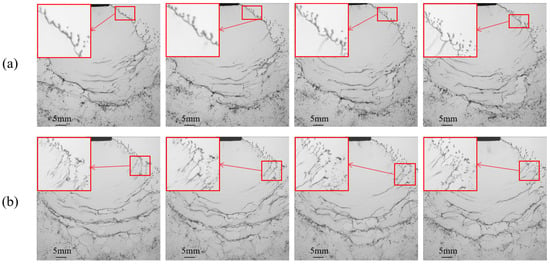
Figure 8.
Comparison of the edge structures of different spraying solutions for the LU120-03 nozzle under the same pressure. (a) Without adjuvant, (b) with an adjuvant concentration of 0.01‰. Perforated-sheet disintegration appears at the edge of the liquid sheet. When adjuvant is added, this results in a larger spray angle at low pressure.
When the liquid is ejected from the nozzle, the pressure differential across the liquid sheet is accountable for the generation of a flapping motion within the liquid sheet []. As the pressure escalates, this flapping perturbation becomes more pronounced. As shown in Table 7, the liquid sheet generated by the LU nozzle experiences an augmented perturbation, with a remarkable increment in the quantity of wave-like structures, and gets closer to the nozzle. Under the influence of the flapping action, the liquid sheet disintegrates prematurely, accompanied by a continuous diminution in both the breakup length and the liquid sheet area. In contrast, the IDK nozzles, owing to their distinct atomization approach, exhibit perforations within the liquid sheet induced by bubble. The emergence and expansion of these perforations attenuate the flapping perturbation of the liquid sheet. Consequently, under the effect of inertia, the breakup length might initially display an increasing tendency. Nevertheless, with a further elevation in pressure, the augmented number of perforations renders the liquid sheet relatively more susceptible to fragmentation, thereby giving rise to a fluctuating pattern in the variation in the breakup length. Additionally, by integrating the alteration in the breakup length with the lateral expansion, the phenomenon of the increase in the area of the liquid sheet for the IDK nozzles can be effectively elucidated.

Table 7.
Comparison of the perforation structure of the liquid sheet under different experimental conditions.
4.4.2. Analysis of Perforation Structural Parameters
There are similarities and differences between the different series of nozzles in the way the perforations are generated. Both the IDK and LU nozzles exhibit perforations induced by the tear mechanism, and the surface perturbation leads to the thickness modulation of the liquid sheet. If the liquid sheet is sufficiently thin, it will be torn due to surface tension and generate perforations []. In addition, the IDK nozzle has perforations caused by the puncture mechanism, which is similar to the phenomenon observed by Cryer et al. when spraying an emulsified solution. They proposed that some prior structures (such as “pre-holes”, “circular object”, and “hole nucleation”) on the liquid sheet before perforation are expected to be the precursors of perforations [,]. In the atomization of the IDK nozzle, bubbles serve as precursors of perforation and will trigger perforation when they rupture under the perturbation.
As can be observed in Figure 9 and Table 7, the different perforation mechanisms result in a notable increase in the number of perforations that can be formed in the liquid sheet of the IDK nozzle. As the pressure escalates, the liquid sheet experiences a relatively more intense perturbation, which in turn drives the thickness modulation of the liquid sheet and the bursting of bubbles. Consequently, the average number of perforations on the LU120-03 nozzle increases from 0.94 to 1.44, and the average number of perforations on the IDK120-03 nozzle increases from 5.8 to 10.1. Moreover, it is observable that the perforations are in closer proximity to the nozzle. Gong [] in his paper used the method of image processing and IPP software to measure the average number of perforations when ST110-03 was sprayed with oil-based emulsion of 0.1% concentration. The values were 19.6, 29.7, and 42.6 at three pressures of 100 kPa, 300 kPa, and 500 kPa, respectively, and the trend of the measurement results in this study was consistent with the trend of the results measured by Gong.
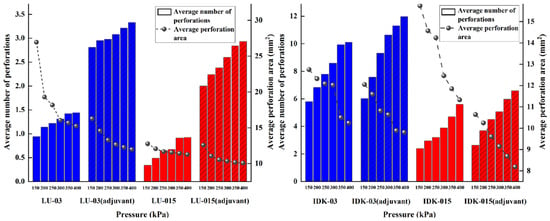
Figure 9.
Comparison between the average number of perforations and the average area of perforations under different experimental conditions. The increase in pressure leads to an augmentation in the number of perforations and a reduction in the area for different nozzles. After adding adjuvant, the variation trend is the same as that with the increase in pressure.
The coalescence of perforations occurs on the liquid sheet, thereby leading to the premature rupture of the liquid sheet. Consequently, as the number of perforations increases, the area available for the expansion of perforations is reduced before individual perforations make contact. The average perforation area of the LU120-03 nozzle decreases from 26.93 mm2 to 15.24 mm2, and that of the IDK120-03 nozzle decreases from 12.75 mm2 to 10.25 mm2. The measurement results indicate that the average area of individual perforations of different nozzles continuously decreases as the pressure increases.
The reduction in surface tension has a particularly pronounced effect on the tearing mechanism. For the LU120-03 nozzle under the same pressure, the average number of perforations in the liquid sheet significantly increases after adding adjuvant. The average number of perforations in the IDK120-03 nozzle shows a slight increase, indicating that the puncture mechanism dominates the perforation mechanism of this nozzle. Observing the dotted line graph in Figure 9, it is discernible that the fluctuation of the average perforation area following the addition of adjuvant is more subdued compared to that without adjuvant. Similar to the liquid sheet structural parameters, which exhibit a downward trend upon adding adjuvant, the overall numerical value is also lower than that of the measurement results without adjuvant.
Under diverse spraying pressures with water and solution, it was ascertained that the influence trend of the nozzle orifice size on the assorted structural parameters of the liquid sheet exhibits consistency. By way of illustration, considering the LU120-03 and LU120-015 nozzles, when the pressure is set at 300 kPa and the spraying solution is water, the breakup length, spray angle, sheet area, average number of perforations, and average perforation area of the LU120-03 nozzle are 41.71 mm, 123.8°, 1389.28 mm2, 1.31, and 16.03 mm2, respectively. Under identical circumstances, the corresponding parameters of the LU120-015 nozzle are 31.26 mm, 114.9°, 710.66 mm2, 0.67, and 11.57 mm2, respectively. When the pressure remains constant but the spraying solution is substituted, the parameters of the LU120-03 nozzle transform to 32.84 mm, 120.3°, 1216.17 mm2, 3.08, and 12.66 mm2, and those of the LU120-015 nozzle become 28.47 mm, 109.9°, 657.23 mm2, 2.6, and 10.35 mm2, respectively. Based on the measurement results, it can be deduced that a larger orifice size corresponds to greater numerical values of the relevant structural parameters of the liquid sheet.
5. Conclusions
In this study, a measurement method of liquid sheet structural parameters based on the LM-YOLO model was proposed. C2f_LSK + MAF + EIoU was introduced to improve the model. For the IDK and LU nozzle datasets, the recognition accuracies were increased, effectively realizing the accurate recognition of the continuous region and perforation structure of the liquid sheet.
Measurements of the liquid sheet structure were accomplished, furnishing a reliable quantitative foundation for relevant analysis. By integrating the measurement results with images, it was demonstrated that pressure exerted a significant influence on various structural parameters of the liquid sheet. When the breakup modes of the liquid sheet differed, certain structural parameters (such as the breakup length and the liquid sheet area) presented different trends with the increase in pressure. A distinct positive correlation was observed between the nozzle orifice size and various structural parameters. Under the same spraying pressure, the liquid sheet ejected from the nozzle with a larger orifice size displayed greater values in structural parameters. After the addition of silicone adjuvant, except for the number of perforations, the parameters were smaller than those of water, and the relative change rate was reduced. Furthermore, it was ascertained that different disintegration modes at the edges of the liquid sheet affected the magnitude of the spray angle.
However, the current research content still suffers from certain deficiencies, including a scarcity of nozzle types, a singularity in solution adjuvants, a lack of full exploration of the impact of different concentrations of the solution adjuvants, and an inability to recognize the microstructural features of the liquid sheet. Future research could be delved into in the following aspects. Expanding experimental conditions to explore the impacts of diverse nozzles and pesticide formulations on the characteristics of the liquid sheet. Training models for the recognition of microstructural features and evaluating their recognition capabilities. Constructing a quantitative relationship between the liquid sheet structure and practical spraying parameters, including volume median diameter (VMD) and relative span (RS), to facilitate more accurate prediction of nozzle performance. Developing algorithms for the recognition of liquid sheet structure in real-time video streams, thereby enabling the deployment of models on lightweight devices. This deployment aims to guide farmers in choosing appropriate spraying nozzles, optimizing spraying operations, and, ultimately, improving the efficiency of agricultural spraying.
Supplementary Materials
The following supporting information can be downloaded at: https://www.mdpi.com/article/10.3390/agronomy15020409/s1, Table S1: The values of all input and the corresponding output for all pressure and nozzle types.
Author Contributions
Conceptualization, W.Y. and R.Z.; methodology, W.Y.; software, W.Y.; validation, R.Z., J.S., P.H., G.X. and Q.W.; formal analysis, W.Y. and L.L.; investigation, W.Y., R.Z., J.S., P.H., G.X. and Q.W.; resources, R.Z., L.C. and L.L.; data curation, W.Y.; writing—original draft preparation, W.Y.; writing—review and editing, W.Y., R.Z., L.L. and P.H.; supervision, R.Z., L.L. and G.X.; project administration, R.Z. and L.C.; funding acquisition, R.Z. and L.C. All authors have read and agreed to the published version of the manuscript.
Funding
This research was supported by the National Key Research and Development Program of China (2023YFD2000204), the National Natural Science Foundation of China (32071907), the Major Scientific and Technological Achievements Cultivation Project of the BAAFS, and the Chen Liping Young Beijing Scholars Project.
Data Availability Statement
The original contributions presented in the study are included in the article; further inquiries can be directed to the corresponding author.
Conflicts of Interest
The authors declare no conflicts of interest.
References
- Altieri, A.; Cryer, S.A.; Acharya, L. Mechanisms, Experiment, and Theory of Liquid Sheet Breakup and Drop Size from Agricultural Nozzles. At. Sprays 2014, 24, 695–721. [Google Scholar] [CrossRef]
- Gaillard, A.; Sijs, R.; Bonn, D. What Determines the Drop Size in Sprays of Polymer Solutions? J. Non-Newton. Fluid 2022, 305, 104813. [Google Scholar] [CrossRef]
- Li, L.; Zhang, R.; Chen, L.; Hewitt, A.J.; He, X.; Ding, C.; Tang, Q.; Liu, B. Toward a Remote Sensing Method Based on Commercial LiDAR Sensors for the Measurement of Spray Drift and Potential Drift Reduction. Sci. Total Environ. 2024, 918, 170819. [Google Scholar] [CrossRef] [PubMed]
- Hu, P.; Zhang, R.; Yang, J.; Chen, L. Development Status and Key Technologies of Plant Protection UAVs in China: A Review. Drones 2022, 6, 354. [Google Scholar] [CrossRef]
- Samuelsen, G. An Experimental Study of the Breakup of a Two-Dimensional Liquid Sheet in the Presence of Co-Flow Air Shear. In Proceedings of the 28th Aerospace Sciences Meeting, Reno, NV, USA, 8–11 January 1990; American Institute of Aeronautics and Astronautics: Reston, VA, USA, 2012. [Google Scholar]
- Kumar, S.P.; Jat, D.; Sahni, R.K.; Jyoti, B.; Kumar, M.; Subeesh, A.; Parmar, B.S.; Mehta, C.R. Measurement of Droplets Characteristics of UAV Based Spraying System Using Imaging Techniques and Prediction by GWO-ANN Model. Measurement 2024, 234, 114759. [Google Scholar] [CrossRef]
- Cryer, S.A.; Altieri, A.L. Role of Large Inhomogeneities in Initiating Liquid Sheet Breakup in Agricultural Atomisation. Biosyst. Eng. 2017, 163, 103–115. [Google Scholar] [CrossRef]
- Makhnenko, I.; Alonzi, E.R.; Fredericks, S.A.; Colby, C.M.; Dutcher, C.S. A Review of Liquid Sheet Breakup: Perspectives from Agricultural Sprays. J. Aerosol Sci. 2021, 157, 105805. [Google Scholar] [CrossRef]
- Miller, P.C.H.; Ellis, M.C.B. Effects of Formulation on Spray Nozzle Performance for Applications from Ground-Based Boom Sprayers. Crop Prot. 2000, 19, 609–615. [Google Scholar] [CrossRef]
- Charalampous, G.; Hadjiyiannis, C.; Hardalupas, Y. Comparative Measurement of the Breakup Length of Liquid Jets in Airblast Atomisers Using Optical Connectivity, Electrical Connectivity and Shadowgraphy. Measurement 2016, 89, 288–299. [Google Scholar] [CrossRef]
- Zhao, H.; Liu, H.-F.; Xu, J.-L.; Li, W.-F.; Cheng, W. Breakup and Atomization of a Round Coal Water Slurry Jet by an Annular Air Jet. Chem. Eng. Sci. 2012, 78, 63–74. [Google Scholar] [CrossRef]
- Gong, C.; Chen, F.; Kang, C. Theoretical and Experimental Studies on the Oil-Based Emulsion Spray. Front. Plant Sci. 2023, 14, 1164200. [Google Scholar] [CrossRef]
- Gong, C.; Li, D.; Kang, C.; Wang, Y. Visualisation of the Evolution of Perforations in Oil-Based Emulsion Sheets Formed by Flat-Fan Spray Nozzles. Biosyst. Eng. 2021, 207, 68–80. [Google Scholar] [CrossRef]
- Gong, C.; Kang, C.; Jia, W.; Yang, W.; Wang, Y. The Effect of Spray Structure of Oil-Based Emulsion Spray on the Droplet Characteristics. Biosyst. Eng. 2020, 198, 78–90. [Google Scholar] [CrossRef]
- Yang, W.; Zhong, W.; Jia, W.; Ou, M.; Dong, X.; Zhang, T.; Ding, S.; Yu, P. The Effect of Oil-in-Water Emulsion Pesticide on the Evolution of Liquid Sheet Rim Disintegration and the Spraying Distribution. Crop Prot. 2024, 177, 106547. [Google Scholar] [CrossRef]
- Yang, W.; Zhong, W.; Jia, W.; Ou, M.; Dong, X.; Zhang, T.; Ding, S.; Jiang, L.; Wang, X. Study on Atomization Mechanisms and Spray Fragmentation Characteristics of Water and Emulsion Butachlor. Front. Plant Sci. 2023, 14, 1265013. [Google Scholar] [CrossRef] [PubMed]
- Yang, W.; Jia, W.; Ou, M.; Zhong, W.; Jiang, L.; Wang, X. Effect of Physical Properties of an Emulsion Pesticide on the Atomisation Process and the Spatial Distribution of Droplet Size. Agriculture 2022, 12, 949. [Google Scholar] [CrossRef]
- Elbasi, E.; Mostafa, N.; AlArnaout, Z.; Zreikat, A.I.; Cina, E.; Varghese, G.; Shdefat, A.; Topcu, A.E.; Abdelbaki, W.; Mathew, S.; et al. Artificial Intelligence Technology in the Agricultural Sector: A Systematic Literature Review. IEEE Access 2023, 11, 171–202. [Google Scholar] [CrossRef]
- Chen, T.; Meng, Y.; Su, J.; Liu, C. Deep CNN Based Droplet Deposition Segmentation for Spray Distribution Assessment. In Proceedings of the 2022 27th International Conference on Automation and Computing (ICAC), Bristol, UK, 1–3 September 2022; IEEE: Piscataway, NJ, USA, 2022; pp. 1–6. [Google Scholar]
- Li, H.; Cryer, S.; Raymond, J.; Acharya, L. Interpreting Atomization of Agricultural Spray Image Patterns Using Latent Dirichlet Allocation Techniques. Artif. Intell. Agric. 2020, 4, 253–261. [Google Scholar] [CrossRef]
- Li, H.; Cryer, S.; Acharya, L.; Raymond, J. Video and Image Classification Using Atomisation Spray Image Patterns and Deep Learning. Biosyst. Eng. 2020, 200, 13–22. [Google Scholar] [CrossRef]
- Dafsari, R.A.; Yu, S.; Choi, Y.; Lee, J. Effect of Geometrical Parameters of Air-Induction Nozzles on Droplet Characteristics and Behaviour. Biosyst. Eng. 2021, 209, 14–29. [Google Scholar] [CrossRef]
- Zhang, R.; Hu, P.; Li, L.; Tang, Q.; Yang, J.; Yang, J.; Chen, L. Fine-Grained Method for Determining Size and Velocity Distribution Patterns of Flat-Fan Nozzle-Atomised Droplets Based on Phase Doppler Interferometer. Comput. Electron. Agric. 2024, 225, 109343. [Google Scholar] [CrossRef]
- Stallbaumer-Cyr, E.M.; Aguilar, J.; Betz, A.R.; Derby, M.M. The Effects of Surfactin on Sprayed Droplets in Flat Fan, Full Cone, and Low Energy Precision Application Bubbler Nozzles: Droplet Formation and Spray Breakup. Front. Mech. Eng. 2024, 10, 1354664. [Google Scholar] [CrossRef]
- Lechler. Agricultural Spray Nozzles and Accessories; Lechler: Metzingen, Germany, 2023; pp. 1–152. [Google Scholar]
- Li, Y.; Hou, Q.; Zheng, Z.; Cheng, M.-M.; Yang, J.; Li, X. Large Selective Kernel Network for Remote Sensing Object Detection. In Proceedings of the IEEE/CVF International Conference on Computer Vision, Paris, France, 2–6 October 2023. [Google Scholar]
- Yang, Z.; Guan, Q.; Zhao, K.; Yang, J.; Xu, X.; Long, H.; Tang, Y. Multi-Branch Auxiliary Fusion YOLO with Re-Parameterization Heterogeneous Convolutional for Accurate Object Detection. In Proceedings of the Chinese Conference on Pattern Recognition and Computer Vision (PRCV), Urumqi, China, 18–20 October 2024. [Google Scholar]
- Diemuodeke, O.E.; Sher, I. Mechanistic Model for the Breakup Length in Jet Atomization. SAE Int. J. Engines 2016, 9, 1314–1319. [Google Scholar] [CrossRef]
- He, K.; Gkioxari, G.; Dollár, P.; Girshick, R. Mask R-CNN. In Proceedings of the 2017 IEEE International Conference on Computer Vision (ICCV), Venice, Italy, 22–29 October 2017. [Google Scholar]
- Bolya, D.; Zhou, C.; Xiao, F.; Lee, Y.J. YOLACT: Real-Time Instance Segmentation. In Proceedings of the IEEE/CVF International Conference on Computer Vision, Seoul, Republic of Korea, 27 October–2 November 2019. [Google Scholar]
- Chen, L.-C.; Zhu, Y.; Papandreou, G.; Schroff, F.; Adam, H. Encoder-Decoder with Atrous Separable Convolution for Semantic Image Segmentation. In Proceedings of the European Conference on Computer Vision (ECCV), Munich, Germany, 8–14 September 2018. [Google Scholar]
- Dorman, R.G. The Atomization of Liquid in a Flat Spray. Br. J. Appl. Phys. 1952, 3, 189–192. [Google Scholar] [CrossRef]
- Sirignano, W.A.; Mehring, C. Review of Theory of Distortion and Disintegration of Liquid Streams. Prog. Energ. Combust. 2000, 26, 609–655. [Google Scholar] [CrossRef]
- Strutt, J.W. Investigation of the Character of the Equilibrium of an Incompressible Heavy Fluid of Variable Density. Proc. Lond. Math. Soc. 1882, 1, 170–177. [Google Scholar]
- Wang, N. Investigation on Breakup and Atomization Characteristics of Hollow Conical Liquid Film Under Cross Flow. Master’s Thesis, Shenyang Aerospace University, Shenyang, China, 2022. [Google Scholar]
- Odier, N.; Balarac, G.; Corre, C.; Moureau, V. Numerical Study of a Flapping Liquid Sheet Sheared by a High-Speed Stream. Int. J. Multiph. Flow 2015, 77, 196–208. [Google Scholar] [CrossRef]
- Cryer, S.A.; Altieri, A.L.; Schmucker, A.L.; Day, K.M. Minimising Atomisation Drift Potential by Exploring the Break-up of Liquid Sheets Using Multiphase Methylated Soybean and Silicon Oil Emulsions. Biosyst. Eng. 2021, 202, 142–151. [Google Scholar] [CrossRef]
Disclaimer/Publisher’s Note: The statements, opinions and data contained in all publications are solely those of the individual author(s) and contributor(s) and not of MDPI and/or the editor(s). MDPI and/or the editor(s) disclaim responsibility for any injury to people or property resulting from any ideas, methods, instructions or products referred to in the content. |
© 2025 by the authors. Licensee MDPI, Basel, Switzerland. This article is an open access article distributed under the terms and conditions of the Creative Commons Attribution (CC BY) license (https://creativecommons.org/licenses/by/4.0/).
